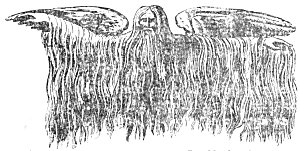Eusebius names as the principal Ministers in the Mysteries of Eleusis, first, the Hierophant, clothed with the attributes of the Grand Architect (Demiourgos) of the Universe. After him came the Dadoukos, or torch-bearer, representative of the Sun: then the altar-bearer, representing the Moon: and last, the Hieroceryx, bearing the caduceus, and representing Mercury. It was not permissible to reveal the different emblems and the mysterious pageantry of initiation to the Profane; and therefore we do not know the attributes, emblems, and ornaments of these and other officers; of which Apuleius and Pausanias dared not speak.
We know only that everything recounted there was marvellous; everything done there tended to astonish the Initiate: and that eyes and ears were equally astounded. The Hierophant, of lofty height, and noble features, with long hair, of a great age, grave and dignified, with a voice sweet and sonorous, sat upon a throne, clad in a long trailing robe; as the Motive-God of Nature was held to be enveloped in His work and hidden under a veil which no mortal can raise. Even His name was concealed, like that of the Demiourgos, whose name was ineffable.
The Dadoukos also wore a long robe, his hair long, and a bandeau on his forehead. Callias, when holding that office, fighting on the great day of Marathon, clothed with the insignia of his office, was taken by the Barbarians to be a King. The Dadoukos led the procession of the Initiates, and was charged with the purifications.
We do not know the functions of the Epibomos or assistant at the altar, who represented the moon. That planet was one of the
p. 412
two homes of souls, and one of the two great gates by which they descended and reascended. Mercury was charged with the conducting of souls through the two great gates; and in going from the sun to the moon they passed immediately by him. He admitted or rejected them as they were more or less pure, and therefore the Hieroceryx or Sacred Herald, who represented Mercury, was charged with the duty of excluding the Profane from the Mysteries.
The same officers are found in the procession of Initiates of Isis, described by Apuleius. All clad in robes of white linen, drawn tight across the breast, .and close-fitting down to the very feet, came, first, one bearing a lamp in the shape of a boat; second, one carrying an altar; and third, one carrying a golden palm-tree and the caduceus. These are the same as the three officers at Eleusis, after the Hierophant. Then .one carrying an open hand, and pouring milk on the ground from a golden vessel in the shape of a woman’s breast. The hand was that of justice: and the milk alluded to the Galaxy or Milky Way, along which souls descended and remounted. Two others followed, one bearing a winnowing fan, and the other a water-vase; symbols of the purification of souls by air and water; and the third purification, by earth, was represented by an image of the animal that cultivates it, the cow or ox, borne by another officer.
Then followed a chest or ark, magnificently ornamented, containing an image of the organs of generation of Osiris, or perhaps of both sexes; emblems of the original generating and producing Powers. When Typhon, said the Egyptian fable, cut up the body of Osiris into pieces, he flung his genitals into the Nile, where a fish devoured them. Atys mutilated himself, as his Priests afterward did in imitation of him; and Adonis was in that part of his body wounded by the boar: all of which represented the loss by the Sun of his vivifying and generative power, when he reached the Autumnal Equinox (the Scorpion that on old monuments bites those parts of the Vernal Bull), and descended toward the region of darkness and Winter.
Then, says Apuleius, came “one who carried in his bosom an object that rejoiced the heart of the bearer, a venerable effigy of the Supreme Deity, neither bearing resemblance to man, cattle, bird, beast, or any living creature: an exquisite invention, venerable from the novel originality of the fashioning; a wonderful,

Moe is the founder of GnosticWarrior.com. He is a father, husband, author, martial arts black belt, and an expert in Gnosticism, the occult, and esotericism.





